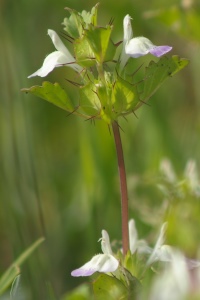
Deutschman Lab Projects
Southern California coastal sage scrub experiences dry summers which often lead to late season fire risk and wet winters that create a shortened growing season for the inhabiting species. Factors such as precipitation, temperature, and fire disturbance govern community structuring and nutrient cycling in these areas; however, anthropogenic pressures are increasingly influential. Coast sage scrub communities have typically been considered nitrogen limited, but recent increased fertilizer use and continued burning of fossil fuels are altering this state of nitrogen limitation. Anthropogenically induced nutrient loading via nitrogen deposition has been evidenced as partially responsible for the conversion of natural shrub land to exotic grassland and now plays a large role in community structuring.
This project will investigate how nitrogen deposition and climate variability impact the growth, fecundity, and competitive ability of a rare species (Acanthomintha ilicifolia, San Diego thorn-mint) and a commonly associated invasive grass (Brachypodium distachyon). Simultaneous study of the effects of Fusilade will simultaneously be examined as a potential management option and the experimental design will allow for the determination of any change in documenting its effectiveness under different climatic and nutrient regimes. This study is unusual in its investigation of the potential interaction of precipitation and nitrogen deposition on the growth, fecundity, and competitive ability of a rare species in the coastal sage scrub community while also providing quantitative data on a potential management strategy that may serve to promote the preservation of the species.
Research Objectives
1. Determine the effects of nitrogen deposition and precipitation variability on the growth, fecundity, and competitive ability of A. ilicifolia, when grown in the presence and absence of an increasingly abundant associated invasive species B. distachyon.
2. Assess the effectiveness of Fusilade in controlling B. distachyon abundance under different precipitation and nitrogen levels while measuring potential negative impacts on A. ilicifolia fecundity or growth.
Lead Biologist: Kyle Rice
This project is partially supported by SDSU's Soil Ecology and Restoration Group (SERG).
Measuring the Effects of Nitrogen Deposition and Precipitation Variability on Rare Species in Coastal Sage Scrub
